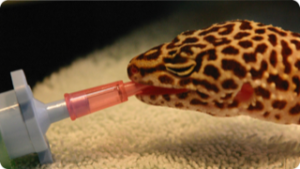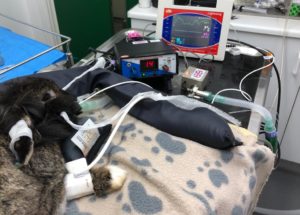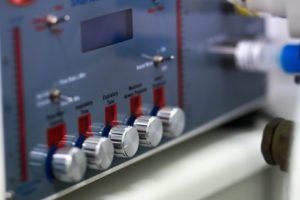Anaesthesia of exotic animals, such as rabbits, guinea pigs, rodents, birds and reptiles can be a little more involved than it is for cats and dogs. A lot of owners have a fear that exotic pets and anaesthetics do not mix and consider it to be a very risky procedure. Some of the fear is probably historical in that some anaesthetics that were available in the past, coupled with an unfamiliarity with a number of species resulted in not infrequent complications, including potential fatalities.
Here at Greenbay Vets, we would love to be able tell you that there is no need to worry and that there is no risk of anaesthetic complications. However, it is not possible to do this, even with the availability of modern anaesthetics. ALL anaesthetics carry a risk, no matter what the species and no matter what the procedure. Even anaesthetics for ‘routine’ procedures on young healthy animals e.g. neutering, carry a degree of risk.
What we need to do is assess our patients health status as thoroughly as possible, then we can take steps to minimise the risks present. Unfortunately, for ‘exotic pets’, to be able to ascertain their health status in the first instance, we often have to administer an anaesthetic (to reduce stress levels in your pet) to enable the taking of required diagnostic samples. The risks associated with anaesthetising an animal whose health status is not fully known is unavoidably higher than for one that is known. This does not mean that the risk is so great that we should not administer an anaesthetic, but that we take steps to minimise this risk as much as is reasonably possible.
Preparing your exotic pet for an anaesthetic
The fact that frequently ‘exotic pets’ will hide signs of disease means that they are, by definition, in a higher anaesthetic risk category than a young healthy cat or dog may be. To help us minimise these risks, please always bring some of your pet’s usual food with them when they come to the surgery. That way they have familiar food with them should we need to admit them e.g. to perform diagnostic tests. This will help reduce their stress levels when they need to be hospitalised before an anaesthetic. It is very important that most ‘exotic pets’ continue to eat prior to their anaesthetic (unlike cats and dogs where the opposite is required) and soon after recovery. DO NOT WITHHOLD FOOD from your ‘exotic pet’ prior to presenting them for anaesthesia/surgery. The exception to this general rule is raptors (birds of prey) and reptiles.
To reduce stress further during hospitalisation we have facilities that mean your pets are kept away from cats and dogs, which most ‘exotics’ consider to be predators.
What happens during anaesthesia?
1. Intra-venous (IV) cannulation – this is standard for dogs and cats, and is performed routinely at Greenbay Vets for rabbit anaesthetics and in other exotic pets where size allows. This allows drugs to be safely administered and for fluids to be given (a drip) if required.
2. Veterinary examination – all patients are examined by a vet prior to anaesthesia.
3. Pre-medication – depending on the procedure pain relief may be administered prior to the anaesthetic starting.
4. Induction – to induce anaesthesia either an injection is given, or in some exotic pets anaesthetic gas is used to initiate the anaesthetic. We also have modern. minimally irritant anaesthetic gases that we use to reduce stress and discomfort.
5. Maintenance – usually anaesthesia is maintained using anaesthetic gas. In most cases this, along with oxygen, is delivered via a tube, which passes down the wind pipe. The majority of ‘exotic pets’ undergoing anaesthesia for surgery are routinely intubated, exactly the same as we do for cats and dogs – this means that the anaesthetic gas, along with oxygen, is delivered via a tube which passes down the wind pipe. The exception to this is small mammals where size and anatomical differences mean that it is generally not feasible. However, size alone is not the only limiting factor – we can even intubate small reptiles that undergo surgery. Rabbits undergoing surgery (including ‘routine’ neutering) are intubated, as this can reduce anaesthetic complications considerably.
6. Recovery – the patient is carefully monitored until they have fully recovered from the anaesthetic.
Monitoring during an anaesthetic
All anaesthetic drugs have effects on the patient’s heart and breathing systems. These effects must be carefully monitored by a dedicated member of staff. At Greenbay Vets our patients are monitored by Registered Veterinary Nurses, or supervised, enrolled Student Veterinary Nurses.
As well as monitoring basic parameters such as heart rate, breathing rate and depth of anaesthesia, at Greenbay Vets we make use of the following monitoring equipment:
- Pulse oximeter – this measures the oxygen content of the blood.
- Capnograph – this measures the carbon dioxide of the air the pet breathes in and out, so enables us to assess the adequacy of breathing. If breathing is not adequate, the pet may need to be ventilated by a nurse or using our automatic ventilator.
- Blood pressure monitor – this is used to ensure blood pressure doesn’t drop too low during a procedure. Support of blood pressure using a drip is often required during anaesthesia.
- Temperature monitor – most pets will get cold during an anaesthetic if not properly monitored and warmed. We use heat pads before, during and after procedures to keep body temperature up; a ‘Bair hugger’ which is a forced warm air blanket and a fluid warmer for any drip fluids being administered to the patient.
- ECG – this measures the electrical activity of the heart.
The monitored parameters are recorded on an anaesthetic chart to look for any trends.
At Greenbay Torquay, we have specialist automatic ventilators to ensure adequate breathing for reptiles, and to assist breathing if required in other species.
After the anaesthetic
During recovery in the surgery patients are monitored until they are awake and warm. Further assessments are made to determine if additional pain relief is required, dependent on the procedure. Once they can go home we will discharge them to you with instructions regarding after-care.



